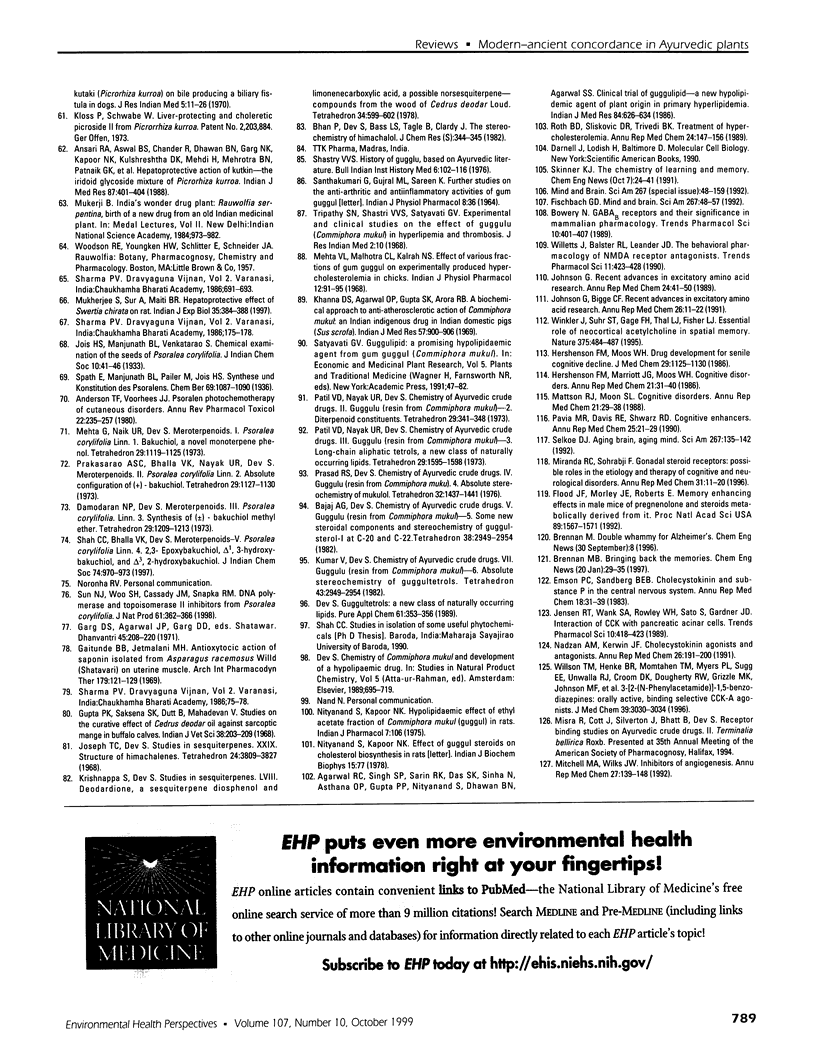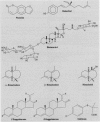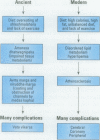Abstract
Ayurveda is the ancient (before 2500 b.c.) Indian system of health care and longevity. It involves a holistic view of man, his health, and illness. Ayurvedic treatment of a disease consists of salubrious use of drugs, diets, and certain practices. Medicinal preparations are invariably complex mixtures, based mostly on plant products. Around 1,250 plants are currently used in various Ayurvedic preparations. Many Indian medicinal plants have come under scientific scrutiny since the middle of the nineteenth century, although in a sporadic fashion. The first significant contribution from Ayurvedic materia medica came with the isolation of the hypertensive alkaloid from the sarpagandha plant (Rouwolfia serpentina), valued in Ayurveda for the treatment of hypertension, insomnia, and insanity. This was the first important ancient-modern concordance in Ayurvedic plants. With the gradual coming of age of chemistry and biology, disciplines central to the study of biologic activities of natural products, many Ayurvedic plants have been reinvestigated. Our work on Commiphora wightti gum-resin, valued in Ayurveda for correcting lipid disorders, has been described in some detail; based on these investigations, a modern antihyperlipoproteinemic drug is on the market in India and some other countries. There has also been concordance for a few other Ayurvedic crude drugs such as Asparagus racemosus, Cedrus deodara, and Psoralea corylifolia.
Full text
PDF






Images in this article
Selected References
These references are in PubMed. This may not be the complete list of references from this article.
- Agarwal R. C., Singh S. P., Saran R. K., Das S. K., Sinha N., Asthana O. P., Gupta P. P., Nityanand S., Dhawan B. N., Agarwal S. S. Clinical trial of gugulipid--a new hypolipidemic agent of plant origin in primary hyperlipidemia. Indian J Med Res. 1986 Dec;84:626–634. [PubMed] [Google Scholar]
- Ammon H. P., Safayhi H., Mack T., Sabieraj J. Mechanism of antiinflammatory actions of curcumine and boswellic acids. J Ethnopharmacol. 1993 Mar;38(2-3):113–119. doi: 10.1016/0378-8741(93)90005-p. [DOI] [PubMed] [Google Scholar]
- Ammon H. P., Wahl M. A. Pharmacology of Curcuma longa. Planta Med. 1991 Feb;57(1):1–7. doi: 10.1055/s-2006-960004. [DOI] [PubMed] [Google Scholar]
- Anderson T. F., Voorhees J. J. Psoralen photochemotherapy of cutaneous disorders. Annu Rev Pharmacol Toxicol. 1980;20:235–257. doi: 10.1146/annurev.pa.20.040180.001315. [DOI] [PubMed] [Google Scholar]
- Ansari R. A., Aswal B. S., Chander R., Dhawan B. N., Garg N. K., Kapoor N. K., Kulshreshtha D. K., Mehdi H., Mehrotra B. N., Patnaik G. K. Hepatoprotective activity of kutkin--the iridoid glycoside mixture of Picrorhiza kurrooa. Indian J Med Res. 1988 Apr;87:401–404. [PubMed] [Google Scholar]
- Aswal B. S., Bhakuni D. S., Goel A. K., Kar K., Mehrotra B. N. Screening of Indian plants for biological activity--Part XI. Indian J Exp Biol. 1984 Sep;22(9):487–504. [PubMed] [Google Scholar]
- Bowery N. GABAB receptors and their significance in mammalian pharmacology. Trends Pharmacol Sci. 1989 Oct;10(10):401–407. doi: 10.1016/0165-6147(89)90188-0. [DOI] [PubMed] [Google Scholar]
- Chowdhry L., Khan Z. K., Kulshrestha D. K. Comparative in vitro and in vivo evaluation of himachalol in murine invasive aspergillosis. Indian J Exp Biol. 1997 Jul;35(7):727–734. [PubMed] [Google Scholar]
- Fischbach G. D. Mind and brain. Sci Am. 1992 Sep;267(3):48–57. [PubMed] [Google Scholar]
- Flood J. F., Morley J. E., Roberts E. Memory-enhancing effects in male mice of pregnenolone and steroids metabolically derived from it. Proc Natl Acad Sci U S A. 1992 Mar 1;89(5):1567–1571. doi: 10.1073/pnas.89.5.1567. [DOI] [PMC free article] [PubMed] [Google Scholar]
- Gaitondé B. B., Jetmalani M. H. Antioxytocic action of saponin isolated from Asparagus racemosus Willd (Shatavari) on uterine muscle. Arch Int Pharmacodyn Ther. 1969 May;179(1):121–129. [PubMed] [Google Scholar]
- Hausen B. M. Centella asiatica (Indian pennywort), an effective therapeutic but a weak sensitizer. Contact Dermatitis. 1993 Oct;29(4):175–179. doi: 10.1111/j.1600-0536.1993.tb03532.x. [DOI] [PubMed] [Google Scholar]
- Hershenson F. M., Moos W. H. Drug development for senile cognitive decline. J Med Chem. 1986 Jul;29(7):1125–1130. doi: 10.1021/jm00157a001. [DOI] [PubMed] [Google Scholar]
- Jensen R. T., Wank S. A., Rowley W. H., Sato S., Gardner J. D. Interaction of CCK with pancreatic acinar cells. Trends Pharmacol Sci. 1989 Oct;10(10):418–423. doi: 10.1016/0165-6147(89)90192-2. [DOI] [PubMed] [Google Scholar]
- Kapil A., Koul I. B., Banerjee S. K., Gupta B. D. Antihepatotoxic effects of major diterpenoid constituents of Andrographis paniculata. Biochem Pharmacol. 1993 Jul 6;46(1):182–185. doi: 10.1016/0006-2952(93)90364-3. [DOI] [PubMed] [Google Scholar]
- Kar K., Puri V. N., Patnaik G. K., Sur R. N., Dhawan B. N., Kulshrestha D. K., Rastogi R. P. Spasmolytic constituents of Cedrus deodara (Roxb.) Loud: pharmacological evaluation of himachalol. J Pharm Sci. 1975 Feb;64(2):258–262. doi: 10.1002/jps.2600640213. [DOI] [PubMed] [Google Scholar]
- Khalid S. A., Duddeck H., Gonzalez-Sierra M. Isolation and characterization of an antimalarial agent of the neem tree Azadirachta indica. J Nat Prod. 1989 Sep-Oct;52(5):922–926. doi: 10.1021/np50065a002. [DOI] [PubMed] [Google Scholar]
- Khanna D. S., Agarwal O. P., Gupta S. K., Arora R. B. A biochemical approach to anti-atherosclerotic action of Commiphora-mukul: an Indian indigenous drug in Indian domestic pigs (Sus scrofa). Indian J Med Res. 1969 May;57(5):900–906. [PubMed] [Google Scholar]
- Mehta V. L., Malhotra C. L., Kalrah N. S. The effects of various fractions of gum guggul on experimentally produced hypercholestraemia in chicks. Indian J Physiol Pharmacol. 1968 Jul;12(3):91–95. [PubMed] [Google Scholar]
- Mukherjee S., Sur A., Maiti B. R. Hepatoprotective effect of Swertia chirata on rat. Indian J Exp Biol. 1997 Apr;35(4):384–388. [PubMed] [Google Scholar]
- Nityanand S., Kapoor N. K. Cholesterol lowering activity of the various fractions of the guggal. Indian J Exp Biol. 1973 Sep;11(5):395–396. [PubMed] [Google Scholar]
- Pasha S. T., Salahuddin A. Influence of anions on enzyme activity of buffalo muscle aldolase. Indian J Biochem Biophys. 1978 Feb;15(1):77–78. [PubMed] [Google Scholar]
- Rastogi R. P., Dhawan B. N. Research on medicinal plants at the Central Drug Research Institute, Lucknow (India). Indian J Med Res. 1982 Dec;76 (Suppl):27–45. [PubMed] [Google Scholar]
- Satyavati G. V., Dwarakanath C., Tripathi S. N. Experimental studies on the hypocholesterolemic effect of Commiphora mukul. Engl. (Guggul). Indian J Med Res. 1969 Oct;57(10):1950–1962. [PubMed] [Google Scholar]
- Selkoe D. J. Aging brain, aging mind. Sci Am. 1992 Sep;267(3):134–142. doi: 10.1038/scientificamerican0992-134. [DOI] [PubMed] [Google Scholar]
- Sharma S., Ramji S., Kumari S., Bapna J. S. Randomized controlled trial of Asparagus racemosus (Shatavari) as a lactogogue in lactational inadequacy. Indian Pediatr. 1996 Aug;33(8):675–677. [PubMed] [Google Scholar]
- Shelton R. M. Aloe vera. Its chemical and therapeutic properties. Int J Dermatol. 1991 Oct;30(10):679–683. doi: 10.1111/j.1365-4362.1991.tb02607.x. [DOI] [PubMed] [Google Scholar]
- Sun N. J., Woo S. H., Cassady J. M., Snapka R. M. DNA polymerase and topoisomerase II inhibitors from Psoralea corylifolia. J Nat Prod. 1998 Mar;61(3):362–366. doi: 10.1021/np970488q. [DOI] [PubMed] [Google Scholar]
- Thyagarajan S. P., Thiruneelakantan K., Subramanian S., Sundaravelu T. In vitro inactivation of HBsAg by Eclipta alba Hassk and Phyllanthus niruri Linn. Indian J Med Res. 1982 Dec;76 (Suppl):124–130. [PubMed] [Google Scholar]
- Venkateswaran P. S., Millman I., Blumberg B. S. Effects of an extract from Phyllanthus niruri on hepatitis B and woodchuck hepatitis viruses: in vitro and in vivo studies. Proc Natl Acad Sci U S A. 1987 Jan;84(1):274–278. doi: 10.1073/pnas.84.1.274. [DOI] [PMC free article] [PubMed] [Google Scholar]
- Visen P. K., Shukla B., Patnaik G. K., Dhawan B. N. Andrographolide protects rat hepatocytes against paracetamol-induced damage. J Ethnopharmacol. 1993 Oct;40(2):131–136. doi: 10.1016/0378-8741(93)90058-d. [DOI] [PubMed] [Google Scholar]
- Vázquez B., Avila G., Segura D., Escalante B. Antiinflammatory activity of extracts from Aloe vera gel. J Ethnopharmacol. 1996 Dec;55(1):69–75. doi: 10.1016/s0378-8741(96)01476-6. [DOI] [PubMed] [Google Scholar]
- Willetts J., Balster R. L., Leander J. D. The behavioral pharmacology of NMDA receptor antagonists. Trends Pharmacol Sci. 1990 Oct;11(10):423–428. doi: 10.1016/0165-6147(90)90150-7. [DOI] [PubMed] [Google Scholar]
- Willson T. M., Henke B. R., Momtahen T. M., Myers P. L., Sugg E. E., Unwalla R. J., Croom D. K., Dougherty R. W., Grizzle M. K., Johnson M. F. 3-[2-(N-phenylacetamide)]-1,5-benzodiazepines: orally active, binding selective CCK-A agonists. J Med Chem. 1996 Jul 19;39(15):3030–3034. doi: 10.1021/jm960205b. [DOI] [PubMed] [Google Scholar]
- Winkler J., Suhr S. T., Gage F. H., Thal L. J., Fisher L. J. Essential role of neocortical acetylcholine in spatial memory. Nature. 1995 Jun 8;375(6531):484–487. doi: 10.1038/375484a0. [DOI] [PubMed] [Google Scholar]




